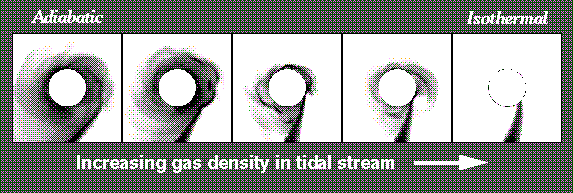
To appear in The Astrophysical Journal, 1995, 445, 889
A preprint of this paper is available in postscript form in our Preprint Library.

Our hydrodynamic models have shown that the circumstellar flow in Algol is relatively independent of the initial speed and direction of the tidal stream. Rather, the flow dynamics are determined primarily by the strength of radiative cooling, which depends on the density of the gas in the mass transfer stream. As cooling becomes more effective the tidal stream is deflected less by the circumstellar gas, the terminal point of the stream reaches closer to the surface of the star (eventually striking the surface), the extent of the circumstellar disk decreases, and the circumstellar flow becomes more clumpy due to thermal instability.
Results from a simulation on a grid of 256 x 256 zones can be viewed by clicking on the icons below.
 An MPEG animation of the Algol simulation.
An MPEG animation of the Algol simulation.